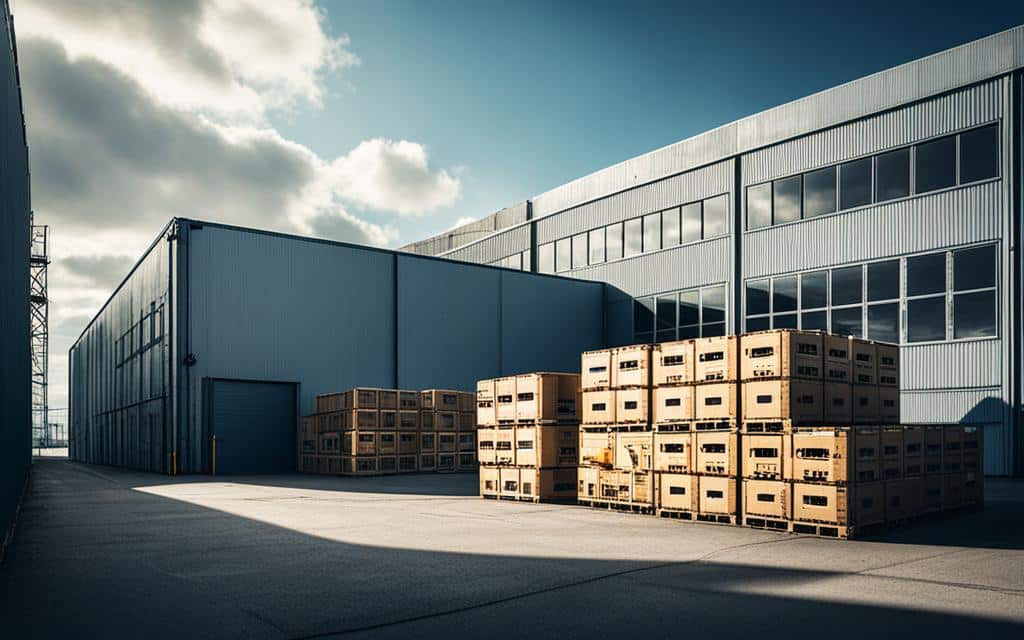Did you know that approximately 50% of all manufactured goods worldwide are produced overseas?
With such a staggering statistic, it’s clear that overseas manufacturing plays a crucial role in the global economy. Companies across industries have turned to outsourcing production to foreign countries for various reasons, including cost savings, access to skilled labor, and market expansion opportunities. However, like any business decision, there are both advantages and disadvantages to consider.
Key Takeaways:
- Overseas manufacturing accounts for around 50% of all manufactured goods globally.
- Businesses opt for overseas manufacturing to achieve cost savings, tap into a larger pool of skilled labor, and explore new markets.
- Language barriers, cultural differences, longer lead times, and potential quality control issues are common drawbacks of overseas manufacturing.
- The impact of overseas manufacturing extends beyond individual companies, affecting global trade dynamics and supply chains.
- Successful overseas manufacturing requires strategic partner selection, effective communication channels, and robust quality control processes.
Advantages of overseas manufacturing
In this section, we will explore the numerous advantages of embracing overseas manufacturing for businesses. Outsourcing production to other countries offers several benefits, including:
1. Cost Savings
One of the key advantages of overseas manufacturing is the potential for cost savings. Production expenses, such as labor and raw materials, can often be significantly lower in certain countries compared to domestic options. This can result in lower manufacturing costs and increased profitability for businesses.
2. Access to a Larger Pool of Skilled Labor
By expanding operations overseas, companies gain access to a larger pool of skilled labor. Different countries may specialize in specific industries or have expertise in certain technologies or manufacturing processes. This enables businesses to tap into a diverse talent pool and benefit from the specialized knowledge and skills of overseas workers.
3. Potential Market Expansion Opportunities
Overseas manufacturing allows businesses to enter new markets and expand their customer base. By establishing production facilities in foreign countries, companies can navigate trade barriers, gain proximity to target markets, and adapt their products or services to cater to local preferences. This can lead to increased market share, brand recognition, and revenue growth.
4. Enhanced Economies of Scale
Overseas manufacturing often enables businesses to achieve economies of scale. By producing larger quantities of goods at reduced costs, companies can reduce per-unit expenses and increase overall efficiency. This can drive greater competitiveness in the market and improve financial performance in the long run.
5. Flexibility and Adaptability
Outsourcing production overseas provides businesses with greater flexibility and adaptability. Companies can quickly adjust production volumes to meet changing market demands, take advantage of seasonal trends, or respond to fluctuations in customer preferences. This agile approach allows businesses to stay competitive and responsive in a dynamic marketplace.
| Advantages of Overseas Manufacturing |
|---|
| 1. Cost Savings |
| 2. Access to a Larger Pool of Skilled Labor |
| 3. Potential Market Expansion Opportunities |
| 4. Enhanced Economies of Scale |
| 5. Flexibility and Adaptability |
Drawbacks of overseas manufacturing
While overseas manufacturing can offer numerous benefits, it is important to acknowledge and address the potential drawbacks that come along with it. Here are some of the key challenges that businesses may encounter when opting for production overseas:
1. Language Barriers
One of the major drawbacks of overseas manufacturing is the language barrier. Communication can become challenging when there are significant language differences between the manufacturing partner and the business. Misunderstandings or miscommunications can often lead to errors in production, delays, and additional costs.
2. Cultural Differences
Cultural differences can also present challenges in overseas manufacturing. Different cultural norms and practices may impact production processes, quality standards, and working relationships. It is crucial to understand and adapt to the cultural nuances of the manufacturing country to ensure seamless collaboration and avoid potential conflicts.
3. Longer Lead Times
When engaging in overseas manufacturing, businesses must consider longer lead times due to logistical complexities. The distance between the manufacturing location and the business can result in increased shipping times and potential delays. This can have an impact on inventory management, production timelines, and the ability to respond quickly to market demands.
4. Potential Quality Control Issues
Maintaining consistent product quality can be a challenge in overseas manufacturing. Businesses may face difficulties in monitoring and ensuring adherence to quality standards and specifications. Lack of oversight and potential differences in quality control practices can lead to variations in the final product, customer dissatisfaction, and reputational damage.
It is important for businesses considering overseas manufacturing to carefully assess and mitigate these drawbacks. Effective communication, cultural understanding, robust supply chain management, and stringent quality control measures are essential for successful production overseas.
Impact of overseas manufacturing on cost, quality, and global trade dynamics
Overseas manufacturing has a significant impact on cost, quality, and global trade dynamics. When businesses outsource production to foreign countries, they can experience both positive and negative effects. Understanding the impact of overseas manufacturing is crucial for businesses seeking to expand their operations globally.
1. Cost Implications
One of the key factors that drive businesses to opt for overseas manufacturing is cost savings. By taking advantage of lower labor and production costs in foreign countries, companies can significantly reduce their expenses. However, it is essential to consider other cost factors such as transportation, tariffs, and customs duties, which can affect the overall cost structure. Balancing these costs is essential to ensure that outsourcing production remains economically viable.
2. Quality Control Measures
When manufacturing abroad, maintaining consistent quality control becomes vital. Language barriers, cultural differences, and logistical challenges can pose obstacles to maintaining quality standards. Businesses must implement robust quality control measures throughout the production process to ensure that products meet the desired specifications and customer expectations.
3. Global Trade Relationships
The decision to engage in overseas manufacturing also has implications for global trade dynamics. As businesses expand their production to foreign countries, they become part of the global supply chain, contributing to the interconnectedness of economies. Developing trade relationships with suppliers and partners in different regions can strengthen a company’s position in the global marketplace, promoting growth and diversification.
Strategies for successful overseas manufacturing
When it comes to overseas manufacturing, implementing effective strategies is crucial for achieving success in production. Here are some key considerations to keep in mind:
First and foremost, choosing the right manufacturing partner is essential. Conduct thorough research to identify reputable companies with a proven track record in your industry. Look for partners that align with your values and have a strong commitment to quality and compliance. Building a long-term relationship with a reliable manufacturing partner can significantly contribute to the success of your overseas production.
Establishing effective communication channels is another vital strategy. Overcoming language barriers and time zone differences can be challenging, but it’s crucial to ensure clear and timely communication with your overseas manufacturing team. Utilize technology to bridge the gap, such as video conferences, project management platforms, and instant messaging tools. Regularly scheduled meetings and timely updates will help streamline operations and prevent misunderstandings.
Lastly, implementing robust quality control processes is imperative. Establish comprehensive quality control protocols to ensure consistency and compliance with your product specifications. Regular on-site inspections, rigorous testing, and proper documentation are essential to maintain high product standards. Collaborate closely with your manufacturing partner to ensure that quality control processes are followed diligently throughout the production cycle.
FAQ
What are the advantages of overseas manufacturing?
Overseas manufacturing offers several benefits including cost savings due to lower labor and production costs, access to a larger pool of skilled labor, and potential market expansion opportunities.
What are the drawbacks of overseas manufacturing?
There are potential challenges associated with overseas manufacturing such as language barriers, cultural differences, longer lead times, and potential quality control issues.
How does overseas manufacturing impact cost, quality, and global trade dynamics?
Outsourcing production to other countries can affect the overall cost structure of a business. It also requires implementing effective quality control measures. Additionally, it can have implications for global trade relationships.
What are some strategies for successful overseas manufacturing?
To navigate overseas manufacturing successfully, it is important to choose the right manufacturing partner, establish effective communication channels, and implement robust quality control processes.











